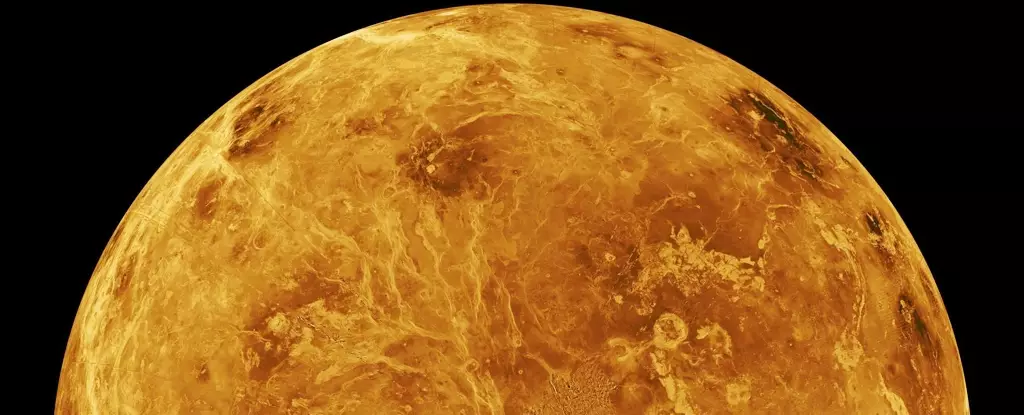In the primordial age of our Solar System, when the planets were still in their infancy, chaos reigned supreme. A deluge of celestial debris hurtled through space, colliding with the newly formed planets at staggering speeds. This frenetic activity led to the creation of craters and basins, featuring prominently on planets like Mercury, Mars, and Earth’s Moon. Even our own planet, despite the erosive forces of wind and water, bears scars from these colossal impacts. However, Venus presents an intriguing anomaly. While its surface is marred with craters, notably missing are those larger than 300 kilometers in diameter, termed impact basins. Recent developments, however, have given scientists fresh insights into this enigmatic planet, revealing not only the existence of such features but also prompting questions regarding their formation and the violent history shared with its planetary neighbors.
The highlight of the recent findings is a geological formation known as the Haastte-Baad Tessera, a structure approximately 1,500 kilometers wide, characterized by concentric rings. This feature is believed to have formed around 3.5 billion years ago, during a period when Venus’s surface was likely still soft due to high internal temperatures. Geologist Vicki Hansen from the Planetary Science Institute proposes that a double impact by two massive celestial bodies may have led to the current structure of the tessera. This discovery is groundbreaking; it suggests that Venus not only experienced significant collisions but did so in a manner that diverges from our expectations of impact crater formations, thereby broadening our understanding of impact geology.
The mechanics behind the Haastte-Baad Tessera are complex. During the time when the rocky planets were developing, their interiors were hypothesized to be molten and highly dynamic, a stark contrast to their cooler, more stable states today. Hansen and her team utilized modeling analysis to delve into the formative processes of the tessera and emerged with a compelling theory surrounding twin impacts. They suggest that when two sizable impactors struck the fragile crust of Venus, both penetrated the thin outer layer, reaching the molten mantle beneath. The subsequent eruption of magma to the surface caused significant geological upheaval, which formed the tessera’s distinctive ringed pattern.
This phenomenon is not unique to Venus; similar multi-ring structures exist elsewhere in the Solar System, illustrating that such violent interactions are a common occurrence. For example, Valhalla on Jupiter’s moon Callisto stands as the largest known multi-ring impact feature, shaped by a massive collision that unleased icy water from below to create its distinctive topography.
Notably, the Haastte-Baad Tessera adds to the ongoing dialogue about the variety of geological responses to impact events across different planetary bodies. Researchers initially anticipated that such structures would conform to certain recognizable designs, particularly those reminiscent of craters seen on Earth, Mars, or the Moon. Yet, the unique geophysical properties of Venus’s crust complicate this paradigm. In Venus’s case, the lack of a thick lithosphere means that impacts do not necessarily yield deep depressions; instead, they can produce low-lying terrains or plateaus. This revelation challenges preconceived notions regarding the morphology of impact craters.
Additionally, Hansen points to the implications of residual material left in the mantle post-impact. The dynamics involved reveal a fascinating interplay where lighter, solid residuum can buoyantly elevate the surface structure, akin to an air-filled mattress underneath a layer of lava. Should this newly formed terrain remain stable, it could set in place a geological feature that bears no resemblance to impact craters observed elsewhere.
The findings concerning Haastte-Baad Tessera underscore the intricate processes that shape planetary bodies in our Solar System. They serve as a reminder that Earth’s geological history, while rich and varied, does not necessarily provide a reliable template for the evolution of other planets. The distinct conditions that characterized early Venus exhibit subtle but important differences, leading to unique geological outcomes. These revelations not only deepen our understanding of Venus but also encourage a reevaluation of impact events generally, highlighting the need to consider a wider array of geological signatures that may emerge from the mysterious and violent past of our Solar System.
As planetary scientists continue to explore such phenomena, the role that historical impacts play in shaping the surfaces of planets like Venus remains an area ripe for further inquiry. The tesserae of Venus might serve as vital clues in uncovering the planet’s tumultuous history and, consequently, our understanding of the overall mechanisms governing planetary formation and evolution. Each new discovery leads to more questions, igniting the thirst for exploration and understanding in the realm of planetary science.

